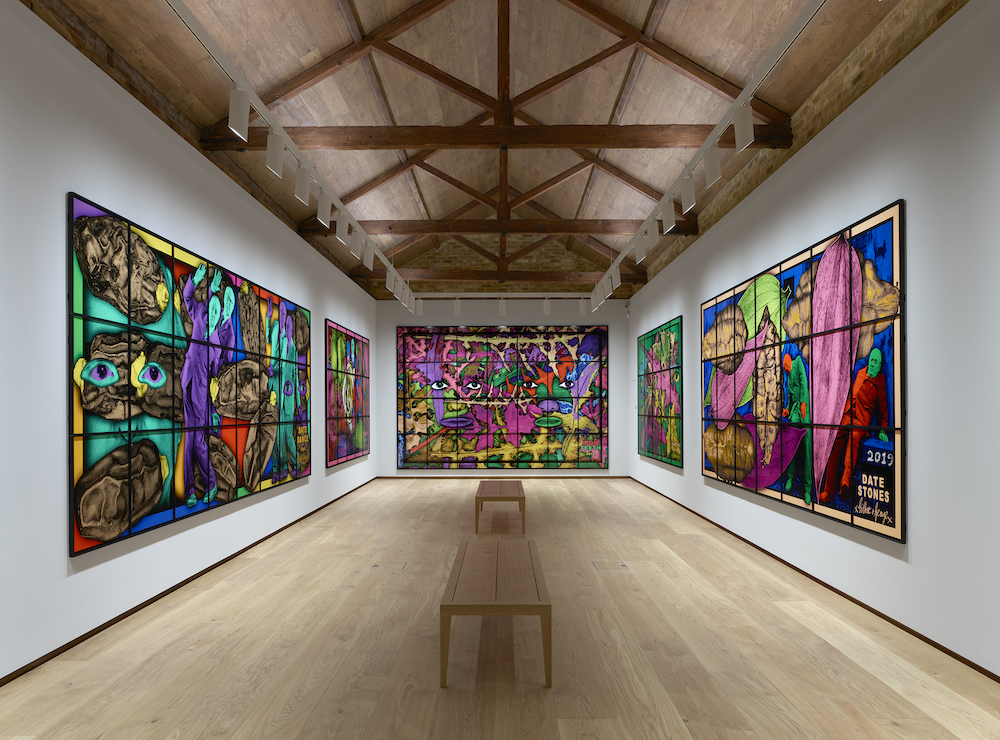Gilbert & George, the quintessentially British pioneering queer artist-duo have staked a clear position within the milieu in which they operate. They have scant tolerance for art-world conventions, yet it is precisely that peevishness and their enduring, long-term collaboration that created the context for the creation of their provocatively lurid and iconic works.
On a recent trip to London, I made my way to their fairly new public art center—situated in the once dodgy Spitalfields district of East London. Gentrification has since transformed the area into a fashionable yet unpretentious neighborhood. The entrance to the Centre, approached from a quiet lane, is gloriously framed by an extravagant green wrought-iron gate distinguished by a rococo G&G flourish. Opened in 2023, the museum holds three gallery spaces in a renovated 19th-century brewery building.
Important figures in British Conceptual art, these two self-proclaimed monarchists—Gilbert Prousch, born in Italy, and British-born George Passmore—are now in their 80s. They are renowned for their nearly identical modes of dress—usually matching suits, which serve as a kind of domestic performance art and mediating foil for reactions to some of their more outré artworks, which often include self-portraiture. They have been constant partners since meeting at Saint Martin’s School of Art in the 1960s—a ferocious and storied alliance that resulted in, as Passmore quipped, “Two people, one artist.” Early formative works included The Singing Sculpture (1969–91), in which the pair painted themselves bronze and sang local public dirges—garnering much attention as a result—and Coming, 1975 (1975), a controversial suite of nine black-and-white photographs depicting ejaculation. In the 1990s, their works took on an increasingly scatological bent, with palettes of hallucinogenic intensity.

©The Gilbert & George Centre (UK) Ltd. Photos by Prudence Cuming.
In some ways the Centre seems like an attempt to hedge their bets—to create a permanent edifice devoted solely to their output. It was always envisioned as a free public venue, in line with their “Art for All” philosophy. Rather than overwhelm the visitor with architectural excess, the brick-enveloped ambiance embraces one with a cocoon-like sensation; the building and its inner courtyard are quietly elegant and tranquil.
One small inner gallery contains prints—white with black lettering—and waggishly irreverent slogans such as “KISS ME,” “FUCK ’EM ALL” and “I’M STRAIGHT.” The larger light-filled galleries are achingly serene, an exercise in unobtrusive, graceful details. On view at the time, “THE PARADISICAL PICTURES” was a visual heaven-on-earth whiplash: a selection of 20-plus manipulated pictures with eye-punching colors. At a distance, the overarching sensation was of quasi-sacred imagery and ersatz stained glass. But closer inspection revealed collages of floating eyes and such detritus as leaves, rotting fruit, flowers and, of course, the artist themselves. Rest (2019) depicts the pair reclining on benches backgrounded by a wildly colorful bed of live and decaying flowers, resulting in a mordantly romantic tableau. This visual insurgence sits in stark contrast to the beautifully restored edifice—perhaps that’s the point.
Gilbert & George are, ultimately, iconoclasts—unconcerned with art-establishment machinations and critique. They are now free to curate their own Centre unfettered and redefine what it means to be a subversive artist in the 21st century.


